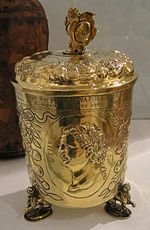Roscheider Hof Open Air Museum

The Roscheider Hof Open Air Museum is the open-air museum and Folklore Museum of the Greater SaarLorLux Region. The museum is situated in Konz, Germany, on the Saar and Mosel rivers, 8 km west of Trier and 30 km east of Luxembourg. It is a museum for rural cultural history in northwest Rhineland-Palatinate and the German-Luxembourg-Lorraine border region. Unlike many other open-air museums, the Roscheider Hof is not a public or community institution. The sponsoring organisation for the museum since its foundation has been the registered, non-profit association founded in 1973, "Volkskunde- und Freilichtmuseum Roscheider Hof, Konz e.V." with over 1000 members in 2007. The museum is financed by membership fees, entrance charges, subsidies and donations. The founder of the association was Prof. Rolf Robischon.
Excerpt from the Wikipedia article Roscheider Hof Open Air Museum (License: CC BY-SA 3.0, Authors, Images).Roscheider Hof Open Air Museum
Roscheiderhof, Konz
Geographical coordinates (GPS) Address Phone number Website External links Nearby Places Show on map
Geographical coordinates (GPS)
| Latitude | Longitude |
|---|---|
| N 49.704722222222 ° | E 6.5972222222222 ° |
Address
Freilichtmuseum Roscheider Hof
Roscheiderhof 1
54329 Konz, Roscheid (Konz)
Rhineland-Palatinate, Germany
Open on Google Maps









